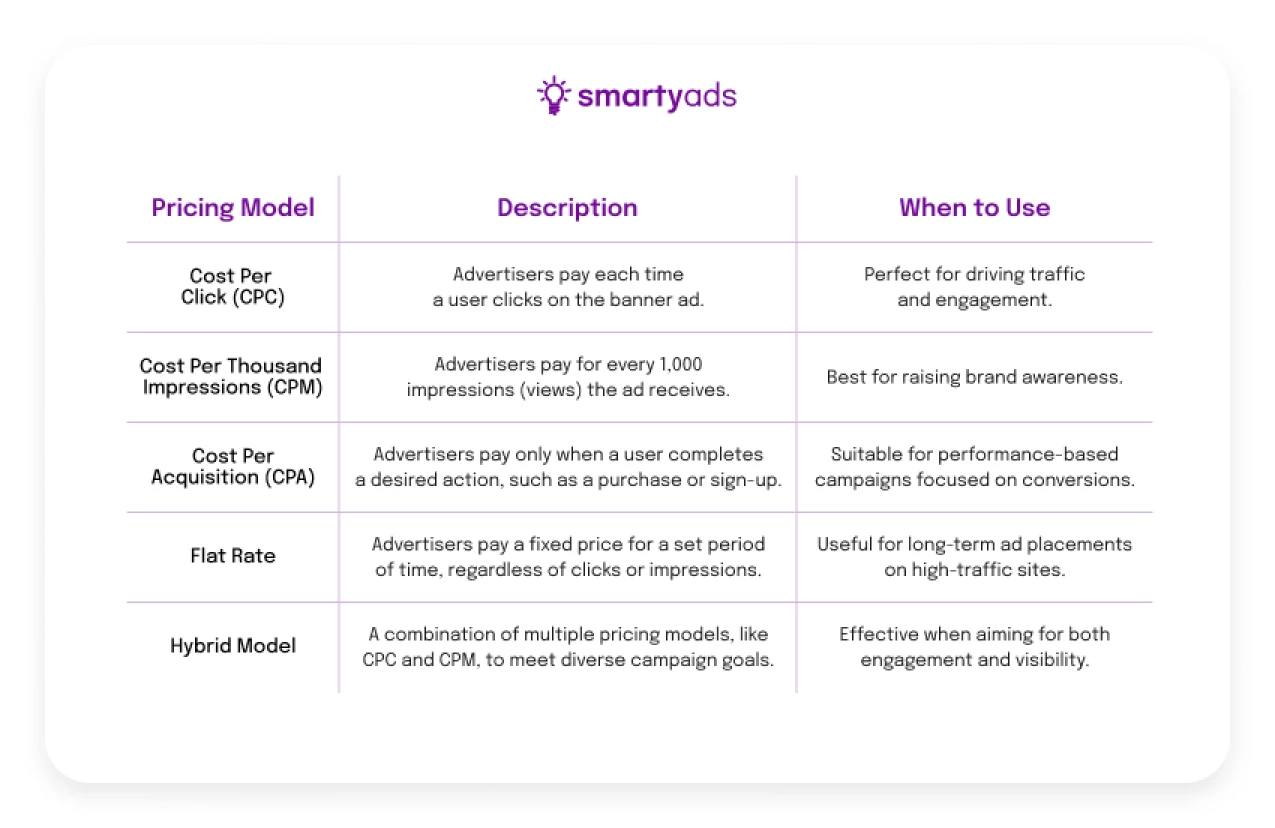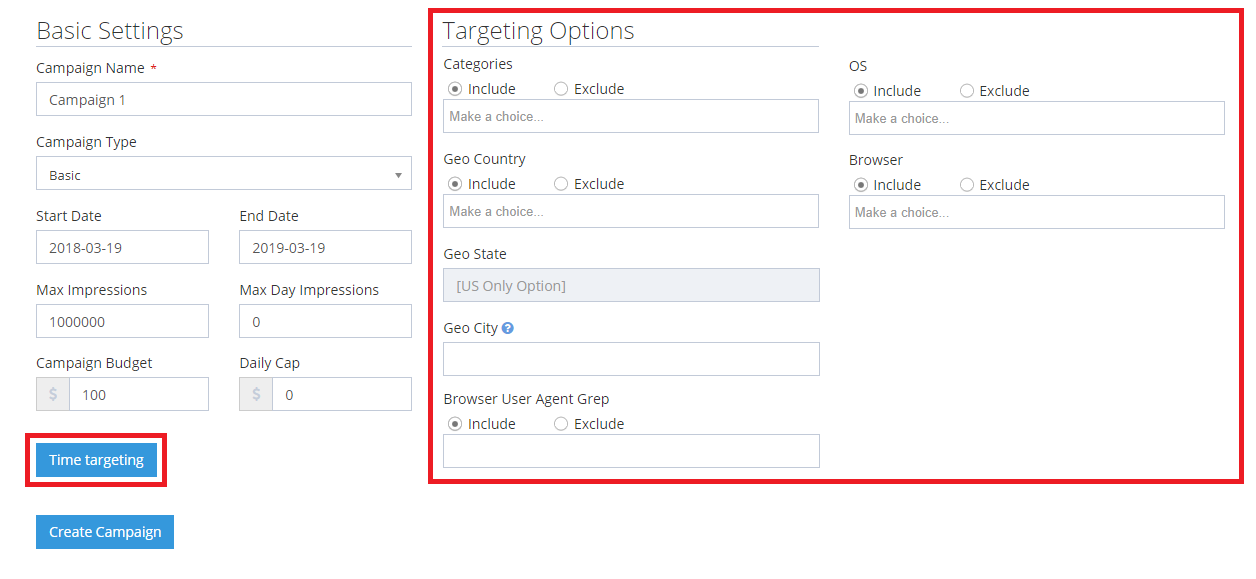Banner ads are an effective tool when it comes to digital marketing and advertising. Even though other formats keep coming to the scene( such as display, rewarder, shoppable ads, etc.), internet banner advertising has never ceased to evolutionize. With interstitial, mobile, video, and banner ads, marketers can achieve high levels of efficiency, effectively avoid banner blindness, and enhance retargeting effectiveness.

What is banner marketing advertising?
Banner marketing advertising, also known as display advertising, refers to the strategy that uses banner ad placements on websites as the key strategy for traffic monetization. First things first, let’s find out what it is and how it looks.
What is a banner ad?
The banner ad is a graphic element stretched across the web page in the static (.jpg, .png, .gif) or interactive form (Flash, in-banner video) with the aim to promote the advertiser's brand.
When users click on an ad banner located at the hosted website, the unit automatically redirects them to the advertiser’s website where they can buy a specific product, fill the form, leave an email address, or commit another target action.
The primary task of the ad banner on the landing page is to inform potential consumers about the product the advertiser wants to sell or to promote the brand as a whole.
As well, it is important for the website banner ad to feature a memorable visual creative in order to stand out among similar web banner ads, engage the visitors, elicit clicks and conversions.
How does banner advertising work
Banner advertising is focused on placing visual ads on websites or apps in highly viewed parts to grab user attention and drive engagement. This advertising brings plenty of benefits and has the potential to create brand awareness, generate clicks, and boost conversions. Advertisers should make banners visually appealing and relevant to the specific needs of their target audiences. It’s also necessary to set up targeting based on browsing behavior, demographics, or interests.
So how does it all work? When a user opens a web page, the banner ad is displayed in a chosen strategic spot (such as the header, footer, or sidebar). Digital banner ads come in different formats and sizes which, as a rule, are suited to the platform they are served at — mobile or desktop.
The ad is served to entice the user to click on it. Banners contain a link to a desired landing page where further action will be required — whether it’s making a purchase or signing up. The performance of banner ads can be measured by metrics like click-through rate (CTR) or impressions. Advertisers can choose the preferred payment model — based on either clicks (CPC) or impressions (CPM). Therefore, banner ads are a flexible and effective way for promoting products or services.
Banner advertising technology
When buying banner ads, many advertisers consider exceptionally top placements on the web page. This approach is not mandatory, especially when the website’s content is good enough. On such websites, the user is more likely to scroll the page to the article’s end, so the banner advertisements at the bottom get more clickable.
The most widespread and highly performing banner ad sizes according to Adsense (and their most frequent locations):
- Leaderboards (728*90) - within the article or before the article
- Half pages (300*600) - located at the left or right side of the web page
- Medium Rectangles (300*250) - within the article or at the bottom
- Large Rectangles (336*280) - within the article or at the bottom
IAB standards feature all sizes and formats for the display banner ads, the most popular of them are:
- Interstitial banner ads. An interactive banner ad that commonly appears in-app or on mobiles at game intervals and covers the whole user screen.
- Rich media banner ads. Advertising banners on websites which are based on HTML5 and can feature videos, games, tweets the user interacts with.
- Expandable banner ads. These banner ads are triggered by user behavior, they expand in size several times when they get into the visibility zone.
- In-banner video ads. Relatively new ad banner format, featuring video files located inside the banner frames.
Banner ad pricing
When it comes to online banner ads , understanding the different pricing models is essential for optimizing campaign budgets and performance. Below is a table outlining the most common banner ad pricing models.

The average CTR (click-through rate) of the banner ad depends on size, type, creative, and platform they’re served at. Thus, CTRs of interstitial banners balance between 1.01%- 1.96% - while for an expandable banner, this number varies from 2.90% to 3.78%.
The experts point out that advertisement banners show much better CTRs and viewability when their message is concise and catchy. Technically, ad banners perform better when served through programmatic and on mobile, where they avoid ad blockers. Read about things you need to know about programmatic buying.

How to plan a banner advertising campaign?
Banner ads help such brands like Apple, IBM, and Google grow their brands and improve product awareness. Smaller brands prefer web advertisement banners for their affordability and the fact that they can be served cross-device, literally reaching every audience segment.
Websites with banner ads can show great effectiveness during the retargeting process. In case users didn’t click on the banner during the first visit, these display ads can target them again on different resources programmatically.
In order to make the web banner advertising work, it is essential to define the purpose of the ad campaign, according to which you can plan the next steps:
- Create a detailed media plan (calculate the optimal budget, and select the placements where target demographics can be found)
- Design memorable, good-quality inventory
- Arrange the banner ad placements on selected websites
- Track the results of an ad campaign and correct the flow when necessary.
During the media plan creation, it is important to think not only about traffic platforms but also about the other ad placements on the site that your website advertising banner will have to compete with for user attention.
Upon gathering the list of websites suitable for the ad banner placement, you can sift it through, selecting only the best ones that bring the biggest amount of traffic. One of the key points to consider is quality and relevance of traffic that is able to convert visitors into customers.
How to create banner ads
To make a banner ad is visually appealing, targeted, and effective it’s crucial to know several key steps to ensure it. Here is a detailed guide on how to create banner ads.
Define your goal
Determine what you want to achieve with your banner ad campaign. Options can be increasing brand awareness and boosting clicks, conversions, or sales. This will further shape the design and messaging.
Know your audience
Understanding the target audience is crucial for the final outcomes. Thoroughly research their demographics, preferences, and behaviors to create an ad that resonates with them.
Choose the right size and format
We’ve provided you with the main banner ad sizes above, so choose the most appropriate option based on where the ad will be placed.
Come up with engaging creatives
Web banners advertising is too often hindered by mediocre creative. Come up with a banner with eye-catching colors and readable and concise text that reflects your brand identity and includes high-quality images.
Craft a compelling CTA
Include a strong, concise call to action with a straightforward message such as “Shop Now”, “Subscribe”, or “Learn More,” to encourage users to take the desired action.
Launch and continuously optimize
Test your banner ad across different platforms and devices to ensure it displays properly. Then, launch the campaign and optimize continuously based on the results received.
Online banner advertising served programmatically
The programmatic approach helps advertisers to seamlessly set up, launch, manage, and optimize banner ad campaigns. SmartyAds DSP enables advertisers to pre-select who should be viewing a particular banner ad according to the browser, geolocation, OS, platform, and other indicators.
As well, it is possible to select the ad banner view frequency and manage how many times the banner will be shown to the particular user in order to avoid banner fatigue.
SmartyAds DSP platform allows to run several banner ad services and campaigns simultaneously, apply retargeting and determine the most beneficial resolutions based on the statistics.

Obviously, the whole four stages of online banners ads planning and execution mentioned before will take place at the advertiser’s dashboard. In this dashboard advertiser configures preferable placement parameters, daily budget spend and launches ad banner campaigns.
The aggregated statistics will provide the advertiser with valuable insights considering the campaign effectiveness, the most productive time when banner ads are most viewable by the users, and shed light on how to optimize existing campaigns.
Summing it up
In conclusion, banner ads are considered a versatile and powerful tool in today’s digital marketing landscape. They can boost engagement, raise brand awareness and lead to increased conversions. Understanding how banner ads work helps businesses and marketing professionals optimize their campaigns for better results.
Register today on SmartyAds DSP — let your ad banners reach the viewers easily!

.webp)



